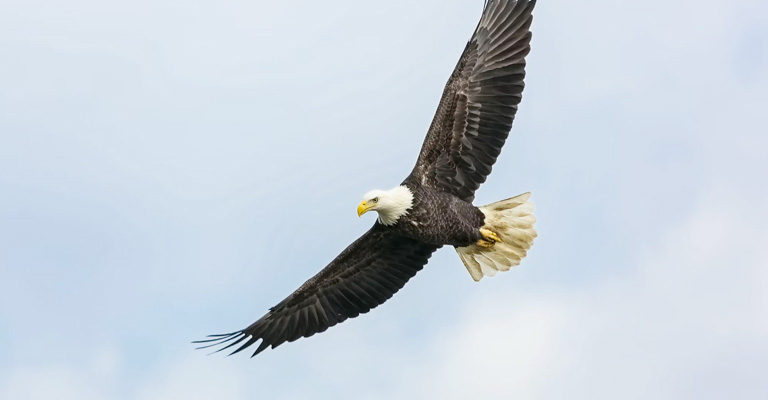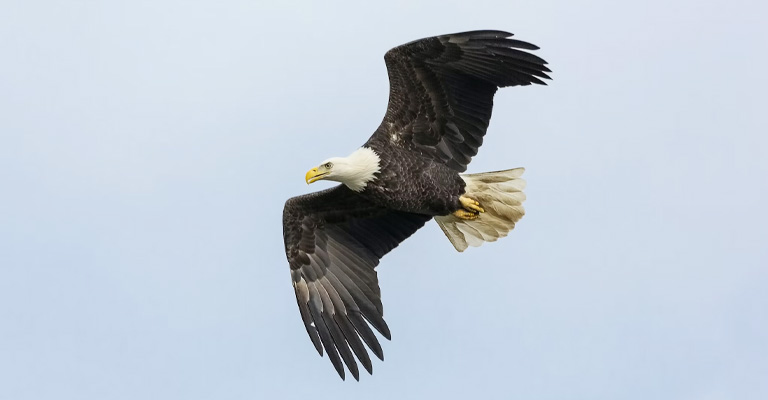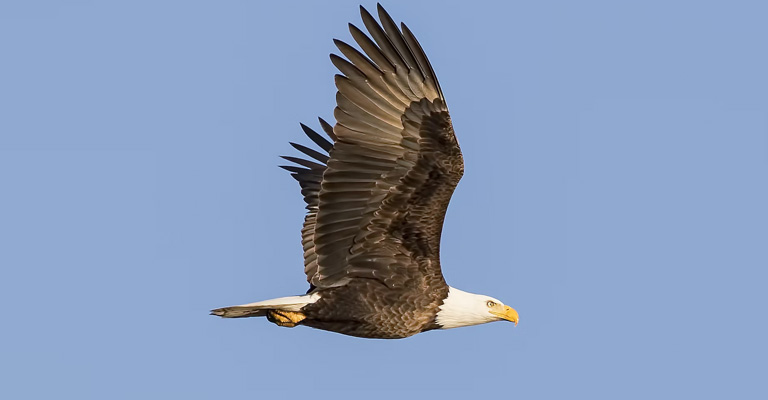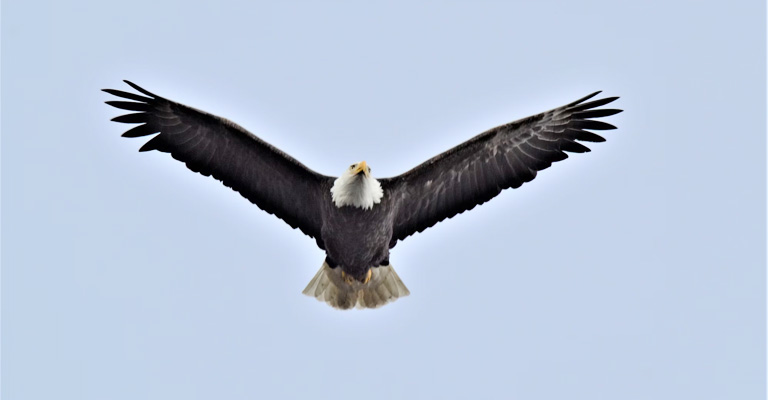The majestic sight of eagles soaring high above the earth is a spectacle that evokes awe and wonder. “Why do eagles fly so high?” is a question that delves into the captivating world of these apex avian predators.
Eagles, with their immense wingspans and exceptional flying abilities, ascend to astonishing heights for a multitude of reasons deeply rooted in their biology and ecological niches.
From seeking prey and avoiding predators to establishing dominance and conserving energy, the flight of eagles is a complex interplay of survival strategies and ecological adaptations.
Exploring the enigma of eagle flight altitude unveils not only their extraordinary natural history but also the intricate balance of nature’s intricacies in avian form and function.

Why Do Eagles Fly So High?
Eagles, with their majestic flight and soaring high above the ground, have compelling reasons for ascending to great altitudes. Here are the key explanations for why eagles fly so high:
Predator’s Advantage
Eagles have fewer natural predators when they ascend to higher altitudes. Flying at greater heights reduces the risk of being preyed upon by terrestrial predators like larger mammals or other birds of prey.
Scouting for Prey
Elevated flight allows eagles to survey larger areas for potential prey. Their keen eyesight can spot movement on the ground, such as small mammals or fish in bodies of water, from considerable distances.
Optimal Vantage Point
Flying high provides eagles with an advantageous vantage point, allowing them to identify prey, competitors, or threats more easily. Their lofty position aids in planning hunting strategies and monitoring their surroundings.
Minimizing Energy Expenditure
Soaring at high altitudes, eagles can utilize rising thermals and updrafts to maintain their position with minimal effort. This reduces the energy expenditure required for sustained flight.
Hunting Strategy
Many eagle species are opportunistic hunters, and flying at higher altitudes gives them a wider perspective on potential hunting opportunities. They can swiftly descend and use gravity to gain speed for an effective hunting swoop.
Avoiding Disturbances
Higher altitudes offer eagles refuge from disturbances like human activities, potential threats, or territorial conflicts. It allows them to maintain a sense of security and undisturbed habitat.
Territorial Display
Flying at great heights can also be a territorial display or a way to assert dominance over a territory. Eagles may engage in aerial acrobatics or vocalizations while soaring, signalling their presence and territory boundaries to rivals.
Eagles’ tendency to fly at high altitudes is not only a product of their remarkable physiology but also a strategic adaptation that enhances their survival, hunting efficiency, and ability to maintain territories in the wild.
How High Can An Eagle Fly?

Eagles are renowned for their remarkable ability to soar to varying heights, with some species reaching impressive altitudes.
Here are some kinds of heights that eagles can achieve:
Low Altitude Flight
Eagles are capable of flying at relatively low altitudes, particularly when they are hunting for prey near the ground. In this mode, they can be just a few meters or feet above the earth’s surface.
Treetop Level
Eagles often glide through the forest canopy at treetop level, particularly when searching for prey or navigating within their territories. This height allows them to maintain visual contact with their surroundings and potential food sources.
Hill and Mountain Slopes
In hilly or mountainous regions, eagles may fly along the slopes, taking advantage of rising air currents created by the topography. This behavior enables them to gain altitude without much effort.
Cliff and Ridge Soaring
Some eagle species, like the Golden Eagle, are known for their exceptional altitude capabilities. They often soar along cliffs and mountain ridges, using updrafts to ascend to higher altitudes.
Thermal Riding
Eagles can reach significant heights by exploiting thermals—rising columns of warm air. These thermals can lift eagles to considerable heights, with some soaring as high as several thousand feet above the ground.
Jet Stream Altitudes
During migration, eagles have been recorded flying at extreme altitudes, even reaching the levels of commercial airliners. In some instances, they can exceed 20,000 feet above sea level during long-distance flights.
Stratospheric Flights
Although rare, there have been instances of eagles colliding with aircraft at altitudes exceeding 30,000 feet, demonstrating their potential for stratospheric flights.
These are not typical altitudes for eagles but indicate their remarkable ability to ascend when needed.
Eagles’ flight heights vary depending on their species, geographic location, and specific activities. Their aerial versatility, from low-level hunting to stratospheric navigation during migration, reflects their adaptability and mastery of the skies.
What Makes Eagles Fly High?

Eagles have several reasons for ascending to great heights, each rooted in their biology, behavior, and ecological needs.
Here are some situations that drive eagles to fly high:
Hunting and Scouting
Eagles ascend to high altitudes to scout for potential prey. Their exceptional vision allows them to spot movement on the ground, making it easier to identify prey like small mammals, fish, or other birds.
Predator Avoidance
Flying at high altitudes reduces the risk of predation by terrestrial predators. Eagles have fewer natural enemies in the sky, so they find safety at greater heights.
Vantage Points
High-altitude flight provides eagles with a superior vantage point. They can survey larger areas, locate prey, competitors, or threats, and plan their hunting strategies more effectively.
Energy Conservation
To minimize energy expenditure, eagles soar at high altitudes using thermals and updrafts. This allows them to maintain their position with minimal effort, conserving energy for hunting and other activities.
Effective Hunting Swoops
High-altitude flight is advantageous for opportunistic hunters. Eagles can dive or swoop down from great heights, using gravity to gain speed for a more effective hunting strike.
Territorial Displays
Soaring at high altitudes can be a territorial display, indicating the eagle’s dominance and asserting control over a particular territory. Aerial displays, including vocalizations and acrobatics, serve to ward off rivals and protect the territory.
Long-Distance Travel
Eagles may fly at high altitudes during long-distance travel or migration. This behavior helps them navigate more efficiently, gain a broader perspective of their surroundings, and cover extensive distances.
The reasons eagles fly high are multifaceted, blending survival strategies, hunting efficiency, and territorial maintenance.
Their incredible adaptability to different situations, from predator avoidance to long-distance travel, is a testament to their mastery of the aerial realm.
What Other Birds Can Fly High As Eagles?

Several bird species share the ability to soar at high altitudes, akin to eagles. Here are some birds that can fly at remarkable heights:
Vultures
Like eagles, vultures are masters of soaring flight. They use thermals to gain altitude, allowing them to reach impressive heights while searching for carrion. Vultures are often seen soaring gracefully in the sky, riding the rising air currents.
Hawks
Many species of hawks, including the Red-tailed Hawk and Broad-winged Hawk, are known for their soaring abilities. They use thermals and updrafts to fly at high altitudes during migration and foraging.
Albatrosses
Albatrosses are oceanic birds that can fly at extremely high altitudes over the open sea. They use dynamic soaring, taking advantage of wind gradients near the surface and at altitude to cover vast distances.
Frigatebirds
Frigatebirds are seabirds known for their impressive aerial abilities. They can fly at high altitudes and stay aloft for extended periods, often using thermal currents and updrafts.
Raptors
Various birds of prey, such as the Peregrine Falcon, exhibit high-altitude flight, especially during hunting. Peregrine Falcons, for instance, reach remarkable altitudes during their stoop or hunting dives.
Swans
Migratory swan species, like the Tundra Swan, can fly at high altitudes during long-distance migrations. They often form V-shaped formations while soaring to minimize air resistance.
Sailplanes
While not a natural bird, sailplanes or gliders are human-designed aircraft that can reach impressive altitudes. They utilize atmospheric conditions, including thermals and updrafts, to achieve soaring flight.
These birds and human-made gliders have developed various strategies to reach high altitudes, reflecting their specific ecological roles and requirements.
Whether it’s for foraging, long-distance migration, or efficient hunting, their ability to fly at extreme heights showcases the diversity of avian adaptation in the sky.
FAQs
Why do eagles fly at such high altitudes?
Eagles fly at high altitudes for a variety of reasons. One primary motivation is to gain a vantage point for hunting, allowing them to spot prey or competitors from a great distance.
What is the significance of eagles flying at high altitudes?
Eagles’ high-altitude flights are significant for their survival and ecological roles. Elevated flight allows them to locate prey more effectively, protect their territory, and communicate with other eagles.
How do eagles fly at high altitudes without getting tired?
Eagles are adept at using thermals and updrafts, which are rising columns of warm air, to maintain their position at high altitudes with minimal energy expenditure. By exploiting these natural phenomena, eagles can glide effortlessly while soaring.
Do all eagle species fly at high altitudes?
While most eagle species are proficient at flying at high altitudes, there can be variations based on their habitat and hunting preferences. Larger eagles, like the Bald Eagle, may not fly as high as smaller species, such as the Golden Eagle, which is known for its remarkable altitude capabilities.
Are there dangers associated with high-altitude flight for eagles?
High-altitude flight comes with some risks, including exposure to severe weather conditions, such as strong winds and storms, which can challenge an eagle’s ability to remain aloft.
Additionally, the high-altitude environment may expose them to territorial disputes with other eagles, leading to aerial confrontations.
Conclusion
The high-flying majesty of eagles serves as a symbol of both natural grandeur and ecological significance.
The question, “Why do eagles fly so high?” leads us into the realms of survival and strategy, where eagles harness their unique adaptations to thrive in their habitats.
Their aerial mastery, from hunting and communication to territory defense and energy conservation, showcases nature’s intricate and ever-evolving design. It is a reminder of the fascinating interplay between biology, environment, and evolution.
The soaring silhouette of an eagle against the vast sky encapsulates the boundless wonders of the avian world, where flight serves as both a means of life and a testament to the astonishing adaptability of these magnificent raptors.